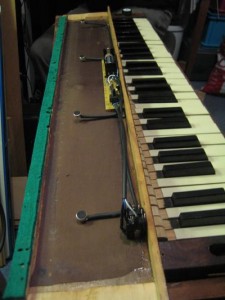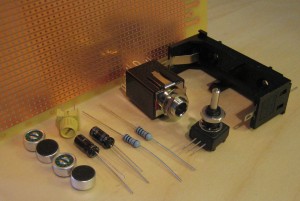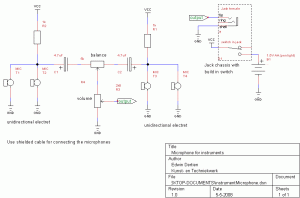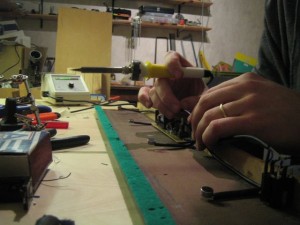Amplifying a reed organ

electrifying instruments
A way of ‘electrifying’ acoustic instruments is addition of a microphone or pickup. While piezo pickups are often used and are very simple to interface (glue the piezo speaker of an anoying melody-playing birthday card to the body of your guitar and you’re there) the sound quality can be quite poor. Especially for instruments which involve air, more than body resonance, a piezo pickup is not the way to go. Electret condenser microphones are however cheap and still quite simple to interface. I’ll show in this post how we used electret mikes to electrify an old Mannborg reed organ.

electret mikes
They are present in almost every device for personal audio, from phone headsets to computer mikes. The thing is that most mikes you’ll find will be omni-directional, so they pickup a lot of noise and unwanted sounds. For good results you’ll have to use directional electret capsules. The difference (in mechanical make-up) is that directional mikes have six tiny holes in the backplate. Don’t ask me why. It probably has something to do with canceling out sound waves that come from all sides… long distance directional miking is still a dark art to me….

electronics
Electret mikes need 1.5V to run their internal pre-amp circuitry. This 1.5V DC voltage needs to be decoupled from the audio signal by means of 4.7 uF capacitors. More mikes can be connected parallel, to capture the sound over a wider range (we used 4 for our organ). With potentiometers it is possible to balance between high and low side-mikes, one end-potentiometer is added to adjust output volume. The battery power is switched on/off by means of the output jack’s switch contacts. That’s all. See the schematic for more details. The schematic is drawn with TinyCad. I have ordered the parts at Farnell, see the partlist. The parts have been mounted on stripboard.



mechanics
In the reed organ the best room available was in the lid of the organ. We mounted the microphones on pieces of metal (fat paper clips) using heat-shrink tube. The microphones are not ‘mechanically’ coupled to the paper clips, they dangle free on a small end of the connecting wire (3mm). This is done to minimize contact noise.

If you’re not into DIY and want to buy commercial products.. check out http://www.microvox.demon.co.uk/products.htm (not that I’m in anyway connected to them, but I think they sell nice products in the sub-shure/akg/sennheiser/SD-systems range)
The sound quality of the youtube clip is hard to judge. Here two soundclips: one is the clean organ part, the other is how it sits in the mix of a song by the Gonnagles
Comments